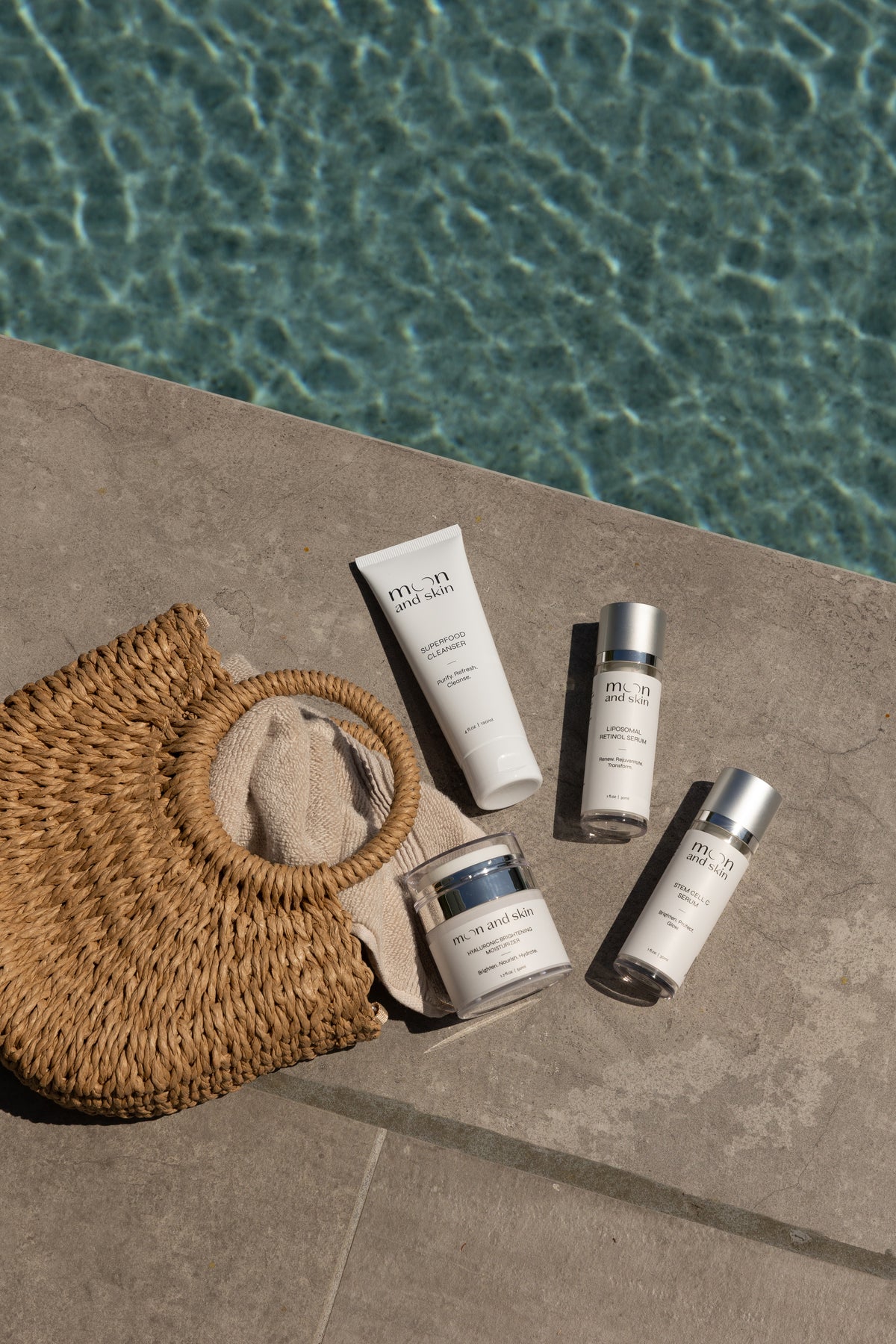Table of Contents
Introduction
Did you know that your skin is the largest organ of your body? It serves as a protective barrier against environmental stressors, and its health is a reflection of our overall well-being. Yet, many of us struggle with the overwhelming task of creating an effective skincare routine. We're often bombarded with products and conflicting advice, leaving us unsure of where to start.
At Moon and Skin, we understand that navigating the world of skincare can be confusing. That's why we've crafted this comprehensive post to guide you in building a skincare routine tailored to your unique needs. Whether you're dealing with dry patches, oily skin, or the first signs of aging, we’ll walk you through the essential steps and highlight our clean, thoughtful products that can support your skin's journey.
Together, we’ll explore the foundational elements of a skincare routine, the importance of each step, and how to adjust your regimen as your skin changes over time. Our goal is to empower you to embrace your skin’s personal journey, much like the phases of the moon—constantly evolving and deserving of care.
Understanding Your Skin Type
Before we dive into building a skincare routine, it’s crucial to understand your skin type. Knowing whether you have oily, dry, combination, sensitive, or normal skin will help you select the right products and steps for your routine.
Oily Skin
If you find that your skin produces excess oil, especially in the T-zone (forehead, nose, and chin), you likely have oily skin. This skin type is prone to breakouts and enlarged pores.
- Key Product: Look for lightweight, oil-free moisturizers and serums. Our Hyaluronic Brightening Moisturizer is a great choice as it hydrates without clogging pores.
Dry Skin
Dry skin feels tight, rough, or flaky and may show signs of premature aging. This type lacks the lipids necessary to retain moisture.
- Key Product: A rich moisturizer is essential. Our Liposomal Retinol Serum can help to hydrate and rejuvenate dry skin.
Combination Skin
Combination skin exhibits characteristics of both oily and dry skin, often showing oiliness in the T-zone and dryness on the cheeks.
- Key Product: Balance is key. Our Superfood Cleanser gently cleanses while nourishing the skin.
Sensitive Skin
Sensitive skin can react to products, leading to redness, itchiness, or burning sensations.
- Key Product: Use gentle, calming products. Our Stem Cell C Serum is formulated to brighten and soothe sensitive skin.
Normal Skin
Normal skin is well-balanced, with no extreme dryness or oiliness.
- Key Product: Maintain your skin's health with products like our Hyaluronic Brightening Moisturizer, which offers hydration without heaviness.
The Essential Steps to Build Your Skincare Routine
Now that you understand your skin type, we can proceed to the essential steps for building a skincare routine. Each step is designed to address specific skin concerns and improve overall skin health.
Step 1: Cleansing
Cleansing is the foundation of any skincare routine. It removes dirt, oil, and makeup from the skin’s surface, allowing other products to penetrate more effectively.
- Morning Routine: In the morning, use a gentle cleanser to refresh your skin. Our Superfood Cleanser nourishes while it cleanses, making it perfect for daily use.
- Evening Routine: At night, a more thorough cleanse is essential to remove makeup and impurities accumulated throughout the day. Consider double cleansing: start with an oil-based cleanser and follow with a water-based one for a deep clean.
Step 2: Exfoliation
Exfoliating helps to slough off dead skin cells, promoting cell turnover and revealing fresh skin underneath.
- Frequency: Depending on your skin type, exfoliate 1-3 times a week. For sensitive or dry skin, opt for gentle exfoliators. Our Liposomal Retinol Serum not only helps with cell turnover but also minimizes irritation.
Step 3: Toning
Toners can help balance the skin’s pH and prepare it for better absorption of subsequent products.
- Choosing a Toner: Look for alcohol-free toners with hydrating ingredients. A hydrating toner can also serve to refresh your skin throughout the day.
Step 4: Treatment
This step involves applying targeted treatments for specific concerns such as acne, pigmentation, or aging.
- Serums: Our Stem Cell C Serum is an excellent choice for brightening and protecting the skin while addressing uneven skin tone.
Step 5: Moisturizing
Moisturizing is crucial for all skin types, even oily skin. It helps to maintain the skin's moisture barrier and keeps it hydrated.
- Daytime: Use a lightweight moisturizer in the morning, ideally one with SPF. Our Hyaluronic Brightening Moisturizer provides hydration without heaviness.
- Nighttime: At night, choose a richer moisturizer that will work while you sleep.
Step 6: Sun Protection
The final step in your morning routine should always be sun protection. Daily sunscreen use is crucial in preventing skin damage and premature aging.
- Recommendation: Look for broad-spectrum SPF that suits your skin type.
Customizing Your Routine as Your Skin Changes
Your skin is not static; it evolves due to factors such as age, environment, and lifestyle. It’s essential to adapt your skincare routine accordingly.
Seasonal Changes
In winter, you may need richer moisturizers to combat dryness, while summer might call for lighter formulations.
Hormonal Changes
Hormonal fluctuations can lead to changes in oil production, so adjust your routine to accommodate breakouts or dryness.
Lifestyle Factors
Diet, stress, and sleep can all impact your skin. Make sure to adjust your products and routines based on how your skin is reacting.
The Importance of Consistency
Regardless of your skin type or concerns, consistency is key. Following your routine diligently will yield the best results over time.
- Tip: Consider setting reminders or creating a checklist to ensure you stick to your routine every day.
Conclusion
Building a skincare routine may seem challenging, but understanding your skin's needs and sticking to the essential steps will empower you to take control of your skin's health.
We invite you to explore our Bundle & Save collection, where you can find our essential products at a better value to build your complete skincare routine. Remember, every phase of life deserves clean, thoughtful skincare—let us support you on your journey.
FAQ
How often should I change my skincare routine?
It’s best to reassess your routine every few months or whenever you notice changes in your skin.
Can I use multiple products at once?
Yes, layering products is common, but ensure they are compatible and suitable for your skin type to avoid irritation.
What should I do if I experience irritation?
If you experience irritation, stop using the product immediately, and consider consulting a dermatologist for tailored advice.
Is it necessary to use a toner?
While toners are not mandatory, they can offer additional hydration and prepare your skin for other products.
How can I tell if a product is right for me?
Always patch-test new products and pay attention to how your skin reacts over time to determine if it’s a good fit.
By following these guidelines and incorporating our clean, effective products, we're confident you can build a skincare routine that meets your unique needs and celebrates your skin's journey.







